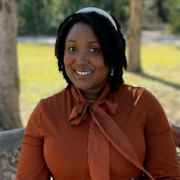Now Read This! Supporting Positive Racial Identity with Literacy-Based Math
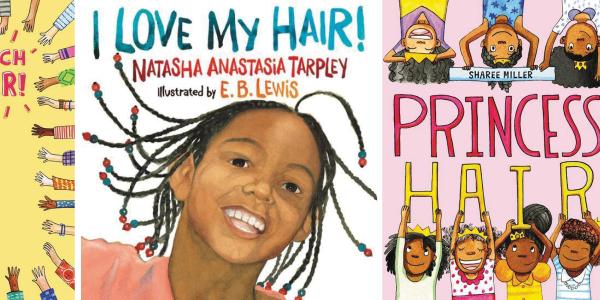
You are here
It’s center time in Ms. Alma’s and Ms. Christine’s prekindergarten class. Stacey, a 4-year-old Black girl, and Elisa, a 4-year-old Latina girl, are playing with dolls. Elisa sits down with her doll and opens a hairstyle book.
Elisa: Which one should I make? (She flips to the page with an illustration of a girl wearing her hair in an afro.)
Elisa: I don’t want to make that hair.
Stacey: Why not?
Elisa: Because I’m going to make a hair that is beautiful.
Stacey looks over at the picture Elisa is referring to and sees that the character is wearing a style very similar to hers. She pauses her play for a bit, frowning as she looks to the floor.
Ms. Alma and Ms. Christine know that young children talk about human differences like hair, skin color, and eye color. Without proper adult support, the children may make hurtful or stereotypical comments about other people that make it difficult for some children to feel good about who they are. These teachers know how critical it is to address such comments. And they also know that they can integrate learning across the curriculum while advancing equity.
There are many ways early childhood educators can help ensure that children are confident in themselves and their families and see the value in one another’s differences. As noted by the 2020 NAEYC position statement on developmentally appropriate practice, educators make every effort to ensure “each child hears and sees their home language, culture, and family experience reflected in the daily interactions, activities, and materials in the early learning setting.”
When messages that celebrate humanity’s differences are woven together with and across academic content, we can
- show just how important these ideas and attitudes about diversity are
- increase engagement as children see themselves reflected in the activities
- save some planning time by creating learning experiences that integrate across content areas and developmental domains
- ensure that math instruction is relevant to children’s lives
Below are a few math activities based on children’s literature for preschool settings. These books and activities send positive messages to children about diversity in hair textures and styles as well as in skin color—and they foster early math learning. Rich with text and visual details, each and every child can benefit from engaging with these books and with the associated math activities.
Visual representation is important in the classroom. While only a few examples of hands-on math activities for preschoolers are included, early childhood educators can create their own activities inspired by these ideas to deepen children’s acceptance, understanding, and joy surrounding diversity. Two of the following activities use dolls with tightly coiled hair, which is a common texture for Black hair. If dolls that look like this aren’t readily available, it is a good idea to get some by purchasing them from the store (if budgets allow), looking for dolls at garage sales, or asking friends or family if they have well-cared-for dolls to donate.
As children play, it is important to pay attention to the topics that interest them and any emerging or explicit negative feelings regarding race. Educators can use this information to create learning experiences that not only teach academic skills but further children’s accurate and positive understandings about race.
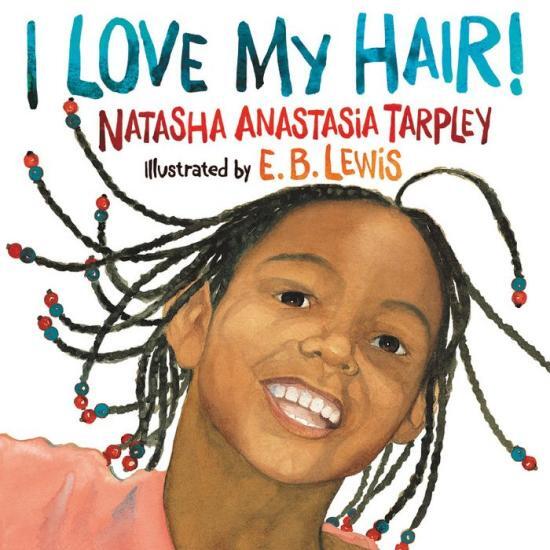 I Love My Hair
I Love My Hair
by Natasha Anastasia Tarpley.
Illus. by E.B. Lewis. 2001. New York:
Little, Brown Books for Young Readers.
I Love My Hair tells an authentic story of a young Black girl getting her hair styled by her mother. The mother takes readers on an imaginative journey of comparing hair styling to yarn being spun in a spinning wheel and crops being planted in rows in a garden as she explains the versatility and beauty of afro-textured hair to her daughter. The daughter expresses the joy she experiences from her hair and celebrates it with a beautiful metaphor of her afro style being free and round as the Earth in our solar system.
Try this! Bead Patterns
A common hairstyle within people of African descent is to wear braided hair adorned with beads. In I Love My Hair, Keyana delights in hearing her beads clink as she walks about. Early childhood educators can use this iconic hair accessory as a math manipulative for patterning. Teachers can provide children with a doll and hair beads (such as pony beads) of different colors or sizes and encourage children to practice stringing on the beads to make patterns. This bead pattern activity also supports the development of fine motor skills.
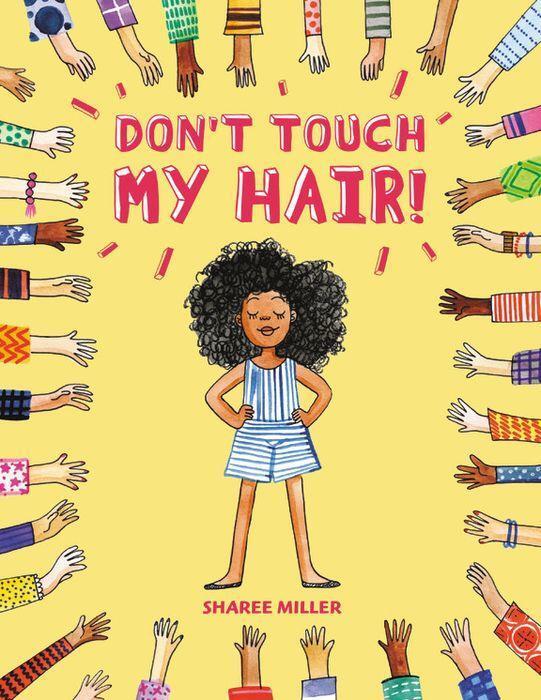 Don’t Touch My Hair
Don’t Touch My Hair
by Sharee Miller. 2019. New York: Little, Brown Books for Young Readers.
Aria, a Black child, loves her hair but does not like it when people touch it without her permission. After finally setting a personal boundary by yelling “Don’t touch my hair!” to all who can hear as she is walking through town, she gets to enjoy her free-flowing afro-textured hair without having to worry about unwanted touches. Friends and community members begin asking to touch her hair and accepting her response, rather than reaching in to touch it without her permission as they did before.
Try this! Roll the Dice/Find the Matching Hands.
In Don’t Touch My Hair, Aria describes the many hands trying to touch her hair. In this math activity, provide children with dice and pictures of hands holding up fingers to show quantities ranging from one finger to five fingers. Children roll their number die, then look for the number of fingers that match. For example, if a child rolls four, they will search for the hand holding up four fingers. If they roll a six, children might find ways to match different finger values that add up to six, such as four and two fingers or five and one fingers. This matching activity can also celebrate dark skin tones if the pictures of the fingers include dark skin tones and the hands are turned where the children can see the hue of the skin, rather than simply the palm.
For added engagement, early childhood educators can use pictures of the hands of children in the classroom. Children will enjoy trying to guess whose hands they are matching with their dice. Educators can also remind children of the importance of getting permission before touching people’s bodies as the activity comes to an end.
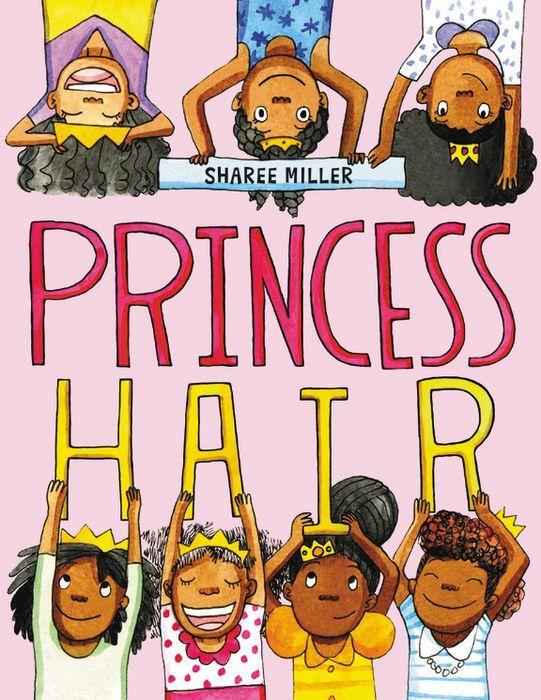 Princess Hair
Princess Hair
by Sharee Miller. 2018. New York:
Little, Brown Books for Young Readers.
This rhyming book celebrates different natural hairstyles for children with afro-textured hair. The narrator describes the diverse hairstyles appropriate for a princess to wear under their crown as they do things they love and as they love their hair. From kinks to Bantu Knots to blowouts, each style is suitable for a princess.
Try this! Matching Numerals and Afro Puffs.
One of the featured hairstyles in Princess Hair is afro puffs (afro-textured hair sectioned into ponytails). After reading the book together, teachers can prompt children to replicate this hair style using classroom dolls with tightly coiled hair. Hand out numeral cards to each child based on their counting skill level (if you don’t have any on hand, you can make your own using index cards), and ask them to match the quantity of afro puffs on the dolls with the number on their cards. If there are limited dolls with tightly coiled hair available, educators can take and print pictures of each style and present them to children with the numeral cards. These photos can be used later to discuss human differences in a social studies unit, to diversify the physical space of the classroom through displays, or to use for other math activities such as patterning or sorting.
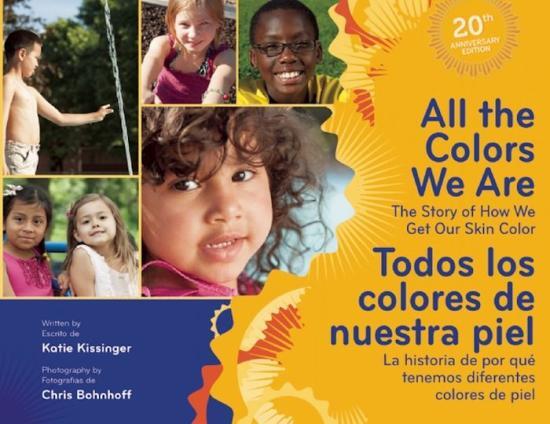 All the Colors We Are: The Story of How We Get Our Skin Color
All the Colors We Are: The Story of How We Get Our Skin Color
by Katie Kissinger. 2014.
St. Paul, Minnesota: Redleaf Press.
This informational text features photographs of real people. Using child-friendly language, Kissinger explains the scientific and historical reasoning for differences in skin color. The author explains that skin color comes from three sources: our ancestors, the sun, and melanin (the pigment that makes skin a certain color).
Try this! Color Match Recipe Cards.
A commonly used diversity activity in the early childhood field is to have children mix paint to find their exact skin color. Teachers can extend this art activity into a math activity focused on quantity, counting, and writing numerals by having children create recipe cards as they make their own unique shades. Provide children with spoons, a bowl, and paints in various skin-tone colors. Help children count and document the number of spoonfuls of each color they use to make their unique color. Educators can then laminate these recipe cards, and children can use them throughout the school year to make the paint that matches their own skin color and that of their classmates.
Copyright © 2022 by the National Association for the Education of Young Children. See permissions and reprints online at NAEYC.org/resources/permissions.
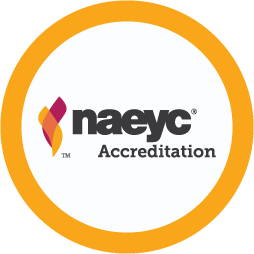 This article supports the following NAEYC Early Learning Programs standards and topics
This article supports the following NAEYC Early Learning Programs standards and topics
Standard 2: Curriculum
2F: Early Mathematics
Standard 3: Teaching
3B: Creating Caring Communities for Learning
Standard 9: Physical Environment
9A: Indoor and Outdoor Equipment, Materials, and Furnishings
Toni Denese Sturdivant, PhD, is an early childhood consultant and vice president of early education and workforce development at Camp Fire First Texas. Her work focuses on racial identity development with young children.
